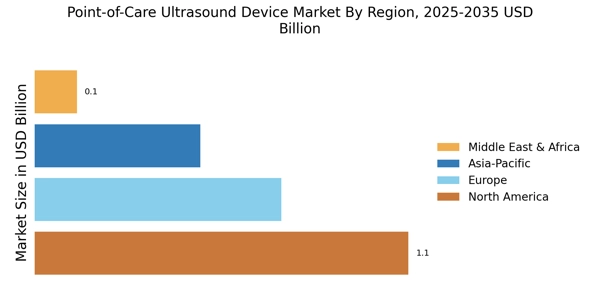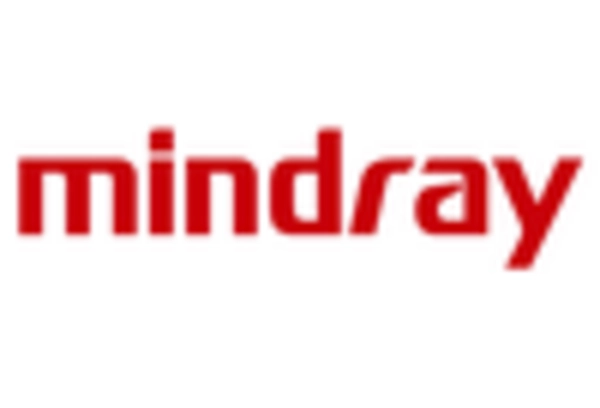Rising Geriatric Population
The Point-of-Care Ultrasound Device Market is significantly influenced by the rising geriatric population, which presents unique healthcare challenges. As the elderly population increases, there is a growing need for efficient diagnostic tools that can be used in various settings, including home care and assisted living facilities. Point-of-care ultrasound devices offer a practical solution, allowing healthcare providers to conduct assessments without the need for patients to travel to hospitals. This convenience is particularly beneficial for elderly patients who may have mobility issues. Market data suggests that the geriatric segment is expected to account for a substantial share of the Point-of-Care Ultrasound Device Market, as healthcare systems adapt to meet the needs of this demographic. The increasing prevalence of chronic diseases among older adults further emphasizes the necessity for accessible diagnostic tools.
Focus on Patient-Centric Care
The Point-of-Care Ultrasound Device Market is increasingly aligning with the focus on patient-centric care. Healthcare providers are recognizing the importance of delivering personalized and immediate care to patients, which is facilitated by point-of-care ultrasound devices. These devices enable clinicians to perform real-time imaging and assessments, allowing for tailored treatment plans that address individual patient needs. The shift towards patient-centric approaches is supported by data indicating that patients prefer receiving care in familiar environments, such as their homes or local clinics. Consequently, the demand for portable ultrasound devices is likely to grow, as they empower healthcare professionals to provide high-quality care outside traditional hospital settings. This trend is expected to drive innovation and investment in the Point-of-Care Ultrasound Device Market.
Cost-Effectiveness and Accessibility
The Point-of-Care Ultrasound Device Market is being propelled by the growing emphasis on cost-effectiveness and accessibility in healthcare. As healthcare costs continue to rise, there is a pressing need for diagnostic solutions that are both affordable and easy to use. Point-of-care ultrasound devices provide a cost-effective alternative to traditional imaging methods, reducing the need for expensive hospital visits and lengthy wait times. Furthermore, these devices can be utilized in a variety of settings, including rural and underserved areas, thereby improving access to essential diagnostic services. The potential for point-of-care ultrasound to enhance healthcare delivery in low-resource environments is particularly noteworthy. As healthcare systems strive to optimize resource allocation, the demand for cost-effective ultrasound solutions is likely to increase, driving growth in the Point-of-Care Ultrasound Device Market.
Technological Advancements in Imaging
The Point-of-Care Ultrasound Device Market is experiencing a surge in technological advancements that enhance imaging capabilities. Innovations such as portable devices with high-resolution imaging and advanced software algorithms are becoming increasingly prevalent. These advancements allow for quicker and more accurate diagnoses, which is crucial in emergency and critical care settings. The integration of artificial intelligence in ultrasound devices is also noteworthy, as it aids in image interpretation and reduces the time required for analysis. As a result, healthcare providers are more inclined to adopt these advanced devices, leading to a projected growth rate of approximately 10% annually in the Point-of-Care Ultrasound Device Market. This trend indicates a shift towards more efficient and effective diagnostic tools in various healthcare settings.
Increased Adoption in Emergency Medicine
The Point-of-Care Ultrasound Device Market is witnessing increased adoption in emergency medicine, driven by the need for rapid assessment and intervention. Emergency departments are increasingly utilizing point-of-care ultrasound devices to facilitate immediate decision-making in critical situations. Studies indicate that the use of ultrasound in emergency settings can significantly reduce the time to diagnosis, which is vital for patient outcomes. The ability to perform bedside imaging allows for quicker treatment decisions, thereby improving patient care. As emergency medicine continues to evolve, the demand for portable and efficient ultrasound devices is expected to rise, contributing to a robust growth trajectory in the Point-of-Care Ultrasound Device Market. This trend underscores the importance of timely diagnostics in enhancing patient survival rates.


















Leave a Comment